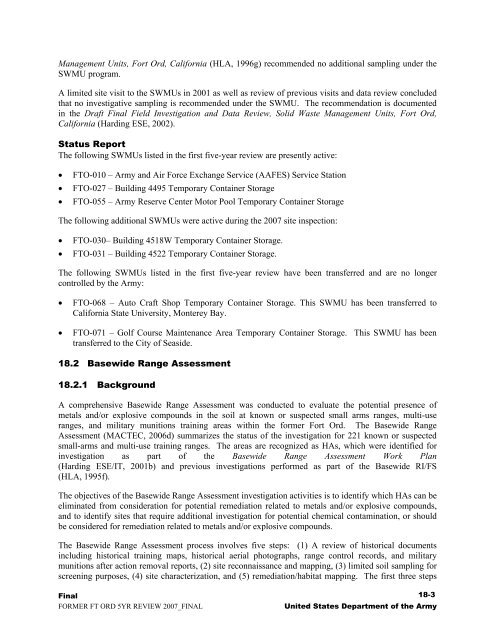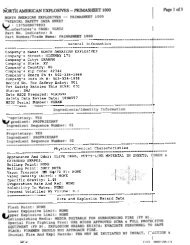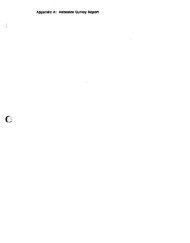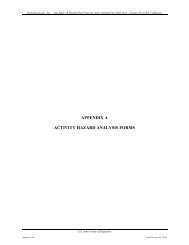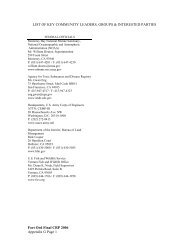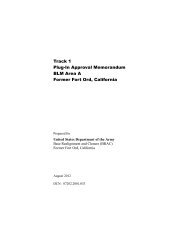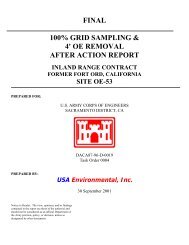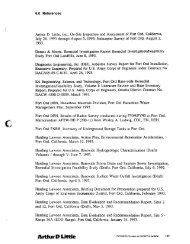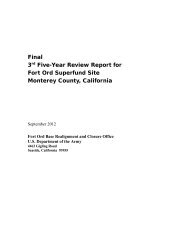Final Second Five-Year Review Report Fort Ord Superfund Site ...
Final Second Five-Year Review Report Fort Ord Superfund Site ...
Final Second Five-Year Review Report Fort Ord Superfund Site ...
You also want an ePaper? Increase the reach of your titles
YUMPU automatically turns print PDFs into web optimized ePapers that Google loves.
Management Units, <strong>Fort</strong> <strong>Ord</strong>, California (HLA, 1996g) recommended no additional sampling under the<br />
SWMU program.<br />
A limited site visit to the SWMUs in 2001 as well as review of previous visits and data review concluded<br />
that no investigative sampling is recommended under the SWMU. The recommendation is documented<br />
in the Draft <strong>Final</strong> Field Investigation and Data <strong>Review</strong>, Solid Waste Management Units, <strong>Fort</strong> <strong>Ord</strong>,<br />
California (Harding ESE, 2002).<br />
Status <strong>Report</strong><br />
The following SWMUs listed in the first five-year review are presently active:<br />
• FTO-010 – Army and Air Force Exchange Service (AAFES) Service Station<br />
• FTO-027 – Building 4495 Temporary Container Storage<br />
• FTO-055 – Army Reserve Center Motor Pool Temporary Container Storage<br />
The following additional SWMUs were active during the 2007 site inspection:<br />
• FTO-030– Building 4518W Temporary Container Storage.<br />
• FTO-031 – Building 4522 Temporary Container Storage.<br />
The following SWMUs listed in the first five-year review have been transferred and are no longer<br />
controlled by the Army:<br />
• FTO-068 – Auto Craft Shop Temporary Container Storage. This SWMU has been transferred to<br />
California State University, Monterey Bay.<br />
• FTO-071 – Golf Course Maintenance Area Temporary Container Storage. This SWMU has been<br />
transferred to the City of Seaside.<br />
18.2 Basewide Range Assessment<br />
18.2.1 Background<br />
A comprehensive Basewide Range Assessment was conducted to evaluate the potential presence of<br />
metals and/or explosive compounds in the soil at known or suspected small arms ranges, multi-use<br />
ranges, and military munitions training areas within the former <strong>Fort</strong> <strong>Ord</strong>. The Basewide Range<br />
Assessment (MACTEC, 2006d) summarizes the status of the investigation for 221 known or suspected<br />
small-arms and multi-use training ranges. The areas are recognized as HAs, which were identified for<br />
investigation as part of the Basewide Range Assessment Work Plan<br />
(Harding ESE/IT, 2001b) and previous investigations performed as part of the Basewide RI/FS<br />
(HLA, 1995f).<br />
The objectives of the Basewide Range Assessment investigation activities is to identify which HAs can be<br />
eliminated from consideration for potential remediation related to metals and/or explosive compounds,<br />
and to identify sites that require additional investigation for potential chemical contamination, or should<br />
be considered for remediation related to metals and/or explosive compounds.<br />
The Basewide Range Assessment process involves five steps: (1) A review of historical documents<br />
including historical training maps, historical aerial photographs, range control records, and military<br />
munitions after action removal reports, (2) site reconnaissance and mapping, (3) limited soil sampling for<br />
screening purposes, (4) site characterization, and (5) remediation/habitat mapping. The first three steps<br />
<strong>Final</strong><br />
18-3<br />
FORMER FT ORD 5YR REVIEW 2007_FINAL United States Department of the Army


